Individuals’ Acceptance to Free-Floating Electric Carsharing Mode: A Web-Based Survey in China
Abstract
:1. Introduction
2. Literature Review
3. Method
3.1. Survey and Data
3.2. Hierarchical Tree-Based Regression (HTBR) Method
4. Descriptive Analysis Findings
4.1. Carsharing Mode Choice under Different Trip Purposes and Trip Distances
4.2. Highest Acceptable Price for Using Carsharing
- Except CPRP, UPTSL, participants’ age, education level and children in the household, all the other variables showed significant effects on the highest acceptable price.
- Compared with females, more males could accept relatively higher trip cost. Specifically, when the price was more than 2 Yuan, 32% of males could accept, but only 23% females could accept.
- Thirty-one percent of non-office workers thought that the price should be smaller than 1 Yuan, while the percentage of office workers (23%) was a little lower. Inversely, 34% of office workers showed acceptance of the price higher than 2 Yuan, while that of non-office workers was 22%. The results revealed that office workers were willing to pay more to use carsharing than non-office workers.
- With the increase of income, the percentage of accepting high price (>2 Yuan) would also increase: 18% for low-income, 33% for middle-income, and 48% for high-income.
- Participants who have private cars were found to be more willing to accept high price than those not having cars. Particularly, the accepting percentage of each price interval for participants who have private cars was 48% for 1–2 Yuan, 27% for 2–3 Yuan, and 5% for >3 Yuan, which were all higher than percentages of participants not having a private.
- Results showed that participants who know about carsharing could accept higher price. Specifically, 30% of participants who know about carsharing could accept the price between 2 and 3 Yuan, which was 16% higher than those who do not know about carsharing.
- When price of carsharing vehicles is less than 100,000, only 14% of them were willing to pay more than 2 Yuan. However, with the price of carsharing vehicles increasing to 200,000, more than 50% of participants could accept a price over 2 Yuan. It indicated that participants would be willing to pay more when carsharing vehicles are more expensive.
4.3. Willingness to Forgo Car Purchases
- Variables, including CPRP, UPTSL, gender, income level, car ownership, awareness of carsharing, and price of carsharing vehicles, showed significant impacts on participants’ willingness to forgo car purchases and participant in carsharing.
- When living in a city without CPRP, 55% of participants were inclined to give up buying a new car. The proportion would increase to 66% among participants living in a city with CPRP. The results revealed that CPRP could provide a meaningful pathway to reduce private car ownership and promote carsharing.
- Only 5% of participants with low satisfaction on UPTSL would be willing to use carsharing instead of buying a car. Conversely, when having high satisfaction, more participants (37%) showed interests in forgoing car purchases. It indicated that with the increase of participants’ satisfaction on UPTSL, their willingness to forgo buying cars would dramatically increase.
- Results showed that males were more insistent on buying cars. The proportion of male participants accepting to forgoing car purchases was 59%, while that of females was 65%.
- A clear relationship between participants’ willingness to give up buying cars and their income level was that the former increased with the latter. Particularly, the willing proportion of participants from the low-income group was 58%, while that of participants from the high-income group was 68%.
- Seventy-five percent of participants who have cars were willing to forgo car purchases, which was obviously more than those who do not have cars (44%). It indicated that carsharing had a positive impact on reducing the number of cars in the household.
- Participants who know about carsharing would be more likely to accept forgoing car purchases (75%) than those who do not know about carsharing (48%). Thus, carsharing organizations should pay more attention to widely advertising carsharing.
5. HTBR Modeling Results
5.1. HTBR Model #1 and Model #2–Predicting Participants’ Carsharing Mode Choice
5.2. HTBR Model #3: Predicting Participants’ Highest Acceptable Price for Using Carsharing
5.3. HTBR Model #4: Predicting Participants’ Willingness to Forgo Car Purchases
6. Conclusions
6.1. Improve Individuals’ Awareness of Carsharing
6.2. Provide Government Supports
6.3. Reasonably Allocate Carsharing Service
6.4. Provide High-Quality and Diversified Service
Acknowledgments
Author Contributions
Conflicts of Interest
References
- Ahmad, S.; Oliveira, J.A.P.D. Determinants of urban mobility in India: Lessons for promoting sustainable and inclusive urban transportation in developing countries. Transp. Policy 2016, 50, 106–114. [Google Scholar] [CrossRef]
- Xenias, D.; Whitmarsh, L. Dimensions and determinants of expert and public attitudes to sustainable transport policies and technologies. Transp. Res. Part A Policy Pract. 2013, 48, 75–85. [Google Scholar] [CrossRef]
- Millard-Ball, A.; Murray, G.; Schure, J.; Fox, C.; Burkhardt, J. Car-sharing: Where and how it succeeds. In Transportation Research Record: Transit Cooperative Research Program Report 108; Transportation Research Board of the National Academies: Washington, DC, USA, 2005. [Google Scholar]
- Chen, T.D.; Kockelman, K.M. Carsharing’s life-cycle impacts on energy use and greenhouse gas emissions. Transp. Res. Part D Transp. Environ. 2016, 47, 276–284. [Google Scholar] [CrossRef]
- Nikitas, A.; Wallgren, P.; Rexfelt, O. The paradox of public acceptance of bike sharing in Gothenburg. Proc. Inst. Civ. Eng. Eng. Sustain. 2016, 169, 101–113. [Google Scholar] [CrossRef]
- Nikitas, A.; Wallgren, P.; Rahe, U. Public bicycles: How the concept of human-oriented “mobility sharing” technology can influence travel behaviour norms and reshape design education. In Proceedings of the 16th International Conference on Engineering and Product Design Education, Design Education and Human Technology Relations; University of Twente: Twente, The Netherlands, 2014; pp. 159–165. [Google Scholar]
- Shaheen, S.A.; Cohen, A.P. Carsharing and personal vehicle services: Worldwide market developments and emerging trends. Int. J. Sustain. Transp. 2013, 7, 5–34. [Google Scholar] [CrossRef]
- Shaheen, S.A.; Cohen, A.P. Innovative Mobility Carsharing Outlook, Winter; Transportation Sustainability Research Center, University of California: Berkley, CA, USA, 2016. [Google Scholar]
- Stephen, M.Z.; David, R.K. User decision-making and technology choices in the U.S. carsharing market. Transp. Policy 2016, 51, 150–157. [Google Scholar]
- Clewlow, R.R. Carsharing and sustainable travel behavior: Results from the San Francisco Bay Area. Transp. Policy 2016, 51, 158–164. [Google Scholar] [CrossRef]
- Stasko, T.H.; Buck, A.B.; Gao, H.O. Carsharing in a university setting: Impacts on vehicle ownership, parking demand, and mobility in Ithaca, NY. Transp. Policy 2013, 30, 262–268. [Google Scholar] [CrossRef]
- Dowling, R.; Kent, J. Practice and public-private partnerships in sustainable transport governance: The case of car sharing in Sydney, Australia. Transp. Policy 2015, 40, 58–64. [Google Scholar] [CrossRef]
- Kim, D.; Ko, J.; Park, Y. Factors affecting electric vehicle sharing program participants’ attitudes about car ownership and program participation. Transp. Res. Part D Transp. Environ. 2015, 36, 96–106. [Google Scholar] [CrossRef]
- Muheim, P.; Reinhardt, E. Car-sharing: The key to combined mobility. World Transp. Policy Pract. 1999, 5, 58–71. [Google Scholar]
- Schmöller, S.; Bogenberger, K. Analyzing external factors on the spatial and temporal demand of car sharing systems. Procedia Soc. Behav. Sci. 2014, 111, 8–17. [Google Scholar] [CrossRef]
- Belgiawan, P.F.; Schmöcker, J.D.; Abou-Zeid, M.; Walker, J.; Lee, T.C.; Ettema, D.F.; Fujii, S. Car ownership motivations among undergraduate students in China, Indonesia, Japan, Lebanon, The Netherlands, Taiwan, and USA. Transportation 2014, 41, 1227–1244. [Google Scholar] [CrossRef]
- Brown, L. Plan B 4.0: Mobilizing to Save Civilization; Earth Policy Institute: New York, NY, USA, 1988. [Google Scholar]
- Kaspi, M.; Raviv, T.; Tzur, M.; Galili, H. Regulating vehicle sharing systems through parking reservation policies: Analysis and performance bounds. Eur. J. Oper. Res. 2006, 251, 969–987. [Google Scholar] [CrossRef]
- Finkhorn, J.; Muller, M. What will be the environmental effects of new free-floating carsharing systems? The case of Car2go in Ulm. Ecol. Econ. 2011, 70, 1519–1528. [Google Scholar] [CrossRef]
- Schulte, F.; Voß, S. Decision support for environmental-friendly vehicle relocations in free—Floating car sharing systems: The case of Car2go. Procedia CIRP 2015, 30, 275–280. [Google Scholar] [CrossRef]
- Cousins, S. Carsharing? An alternative vision and a bit of history. World Transp. Policy Pract. 1999, 5, 47–56. [Google Scholar]
- Cartenì, A.; Cascetta, E.; Luca, S.D. A random utility model for park & carsharing services and the pure preference for electric vehicles. Transp. Policy 2016, 48, 49–59. [Google Scholar]
- Wang, M.; Martin, E.; Shaheen, S. Carsharing in Shanghai, China: Analysis of behavioral response to a local survey and potential competition. Transp. Res. Rec. 2012, 24, 86–95. [Google Scholar] [CrossRef]
- Cervero, R. City carshare: First-year travel demand impacts. Transp. Res. Rec. J. Transp. Res. Board 2003, 1839, 159–166. [Google Scholar] [CrossRef]
- Martin, E.; Shaheen, S.A. Greenhouse gas emission impacts of carsharing in North America. IEEE Trans. Intell. Transp. Syst. 2011, 12, 1074–1086. [Google Scholar] [CrossRef]
- Voltti, V. Potential and Impacts of Car-Sharing in the Helsinki Metropolitan Area, Tampere and Turku; Finnish Transport Agency: Helsinki, Finland, 2010; p. 52. [Google Scholar]
- Kawgan, K.I. Early adopters of carsharing with and without BEVs with respect to gender preferences. Eur. Transp. Res. Rev. 2015, 7, 1–11. [Google Scholar] [CrossRef]
- Sioui, L.; Morency, C.; Trepanier, M. How Carsharing Affects the Travel Behaviors of Households? In Proceedings of the World Conference on Transport Research, Lisbon, Portugal, 11 July 2010. [Google Scholar]
- Katzev, R. Car-sharing: A new approach to urban transportation problems. Anal. Soc. Issues Public Policy 2003, 3, 65–86. [Google Scholar] [CrossRef]
- Walb, C.; Loudon, W. Evaluation of the Short-Term Auto Rental (STAR) Service in San Francisco; Urban Mass Transportation Administration, U.S. Department of Transportation: Washington, DC, USA, 1986. [Google Scholar]
- Khan, A.; Willumsen, L.G. Modelling car ownership and use in developing countries. Traffic Eng. Control 1986, 27, 554–560. [Google Scholar]
- Firnkorn, J.; Müller, M. Free-floating electric carsharing-fleets in smart cities: The dawning of a post-private car era in urban environments? Environ. Sci. Policy 2015, 45, 30–40. [Google Scholar] [CrossRef]
- Ruhrort, L.; Steiner, J.; Graff, A.; Hinkeldein, D.; Hoffmann, C. Carsharing with electric vehicles in the context of users’ mobility needs—Results from user-centred research from the BeMobility field trial (Berlin). Int. J. Automot. Technol. Manag. 2014, 14, 286–305. [Google Scholar] [CrossRef]
- Wappelhorst, S.; Sauer, M.; Hinkeldein, D.; Bocherding, A.; Glaß, Y. Potential of electric carsharing in urban and rural areas. Transp. Res. Procedia 2014, 4, 374–386. [Google Scholar] [CrossRef]
- Shaheen, S.A.; Martin, E. Carsharing market potential in China: A case study of Beijing. In Proceedings of the 13th ITS World Congress, London, UK, 8–12 October 2006. [Google Scholar]
- Shaheen, S.A.; Martin, E. Demand for carsharing systems in Beijing, China: An exploratory study. Int. J. Sustain. Transp. 2010, 4, 41–55. [Google Scholar] [CrossRef]
- Hui, Y.; Ding, M.; Zheng, K.; Liu, Y. Research on trip chain characteristics of round-trip car-sharing users in China: A case study in Hangzhou City. In Proceedings of the Transportation Research Board 96th Annual Meeting, Washington, DC, USA, 8–12 January 2017. [Google Scholar]
- Lemon, S.C.; Roy, J.; Clark, M.A. Classification and regression tree analysis in public health: Methodological review and comparison with logistic regression. Ann. Behav. Med. 2003, 26, 172–181. [Google Scholar] [CrossRef] [PubMed]
- Washington, S.; Wolf, J.; Guensler, R. Binary recursive partitioning method for modeling hot-stabilized emissions from motor vehicles. Transp. Res. Rec. 1997, 1587, 96–105. [Google Scholar] [CrossRef]
- Yan, X.D.; Zhang, F.; Gao, D.; Zeng, C.; Xiang, W.; Zhang, M. Accumulations of heavy metals in roadside soils close to Zhaling, Eling and Nam Co lakes in the Tibetan Plateau. Int. J. Environ. Res. Public Health 2013, 10, 2384–2400. [Google Scholar] [CrossRef] [PubMed]
- Lederer, P.R.; Cohn, L.F.; Guensler, R.; Harris, R.A. Effect of on-ramp geometric and operational factors on vehicle activity. J. Transp. Eng. 2005, 131, 18–26. [Google Scholar] [CrossRef]
- Weng, J.X.; Zheng, Y.; Qu, X.; Yan, X. Development of a maximum likelihood regression tree-based model for predicting subway incident delay. Transp. Res. Part C Emerg. Technol. 2015, 57, 30–41. [Google Scholar] [CrossRef]
- Roberts, C.A.; Washington, S.; Leonard, J. Forecasting dynamic vehicular activity on freeways: Bridging the gap between travel demand and emerging emissions models. Transp. Res. Board 1999. [Google Scholar] [CrossRef]
- Skaltsas, G.; Rakas, J.; Karlaftis, M.G. An analysis of air traffic controller-pilot miscommunication in the NextGen environment. J. Air Transp. Manag. 2013, 27, 46–51. [Google Scholar] [CrossRef]
- Chang, L.Y.; Chen, W.C. Data mining of tree-based models to analyze freeway crash frequency. J. Saf. Res. 2005, 36, 365–375. [Google Scholar] [CrossRef] [PubMed]
- Karlaftis, M.G.; Golias, I. Effects of road geometry and traffic volumes on rural roadway accident rates. Accid. Anal. Prev. 2002, 34, 357–365. [Google Scholar] [CrossRef]
- Rengarasu, T.M.; Hagiwara, T.; Hirasawa, M. Development of a hierarchical tree based regression model for rural traffic crashes. J. East. Asia Soc. Transp. Stud. 2011, 9, 1731–1746. [Google Scholar]
- Kato, H.; Inagi, A.; Igo, T. Awareness and potential choices of carsharing: Comparative analysis of data from four Japanese cities. In Proceedings of the Transportation Research Board 91th Annual Meeting, Washington, DC, USA, 22–26 January 2012. [Google Scholar]
- Luca, S.D.; Pace, R.D. Modelling users’ behaviour in inter-urban carsharing program: A stated preference approach. Transp. Res. Part A Policy Pract. 2015, 71, 59–76. [Google Scholar] [CrossRef]
- Shaheen, S.A.; Schwartz, A.; Wipyewski, K. Policy considerations for carsharing and station cars: Monitoring growth, trends, and overall impacts. Transp. Res. Rec. J. Transp. Res. Board 2004, 1887, 128–136. [Google Scholar] [CrossRef]
- Shaheen, S.A.; Cohen, A.P.; Martin, E. Carsharing parking policy: A review of North American practices and San Francisco Bay area case study. Transp. Res. Rec. J. Transp. Res. Board 2010, 2187, 146–156. [Google Scholar] [CrossRef]
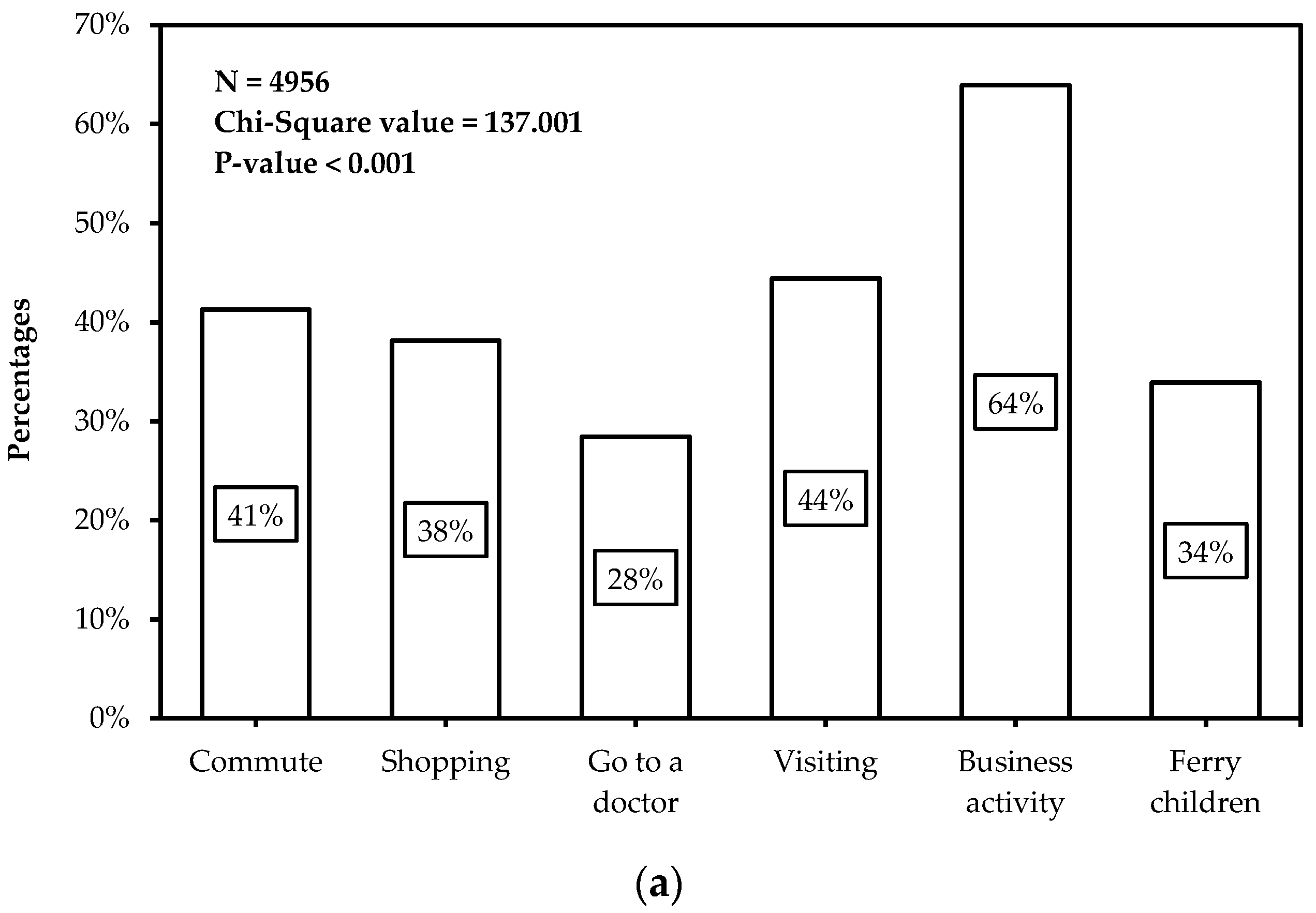
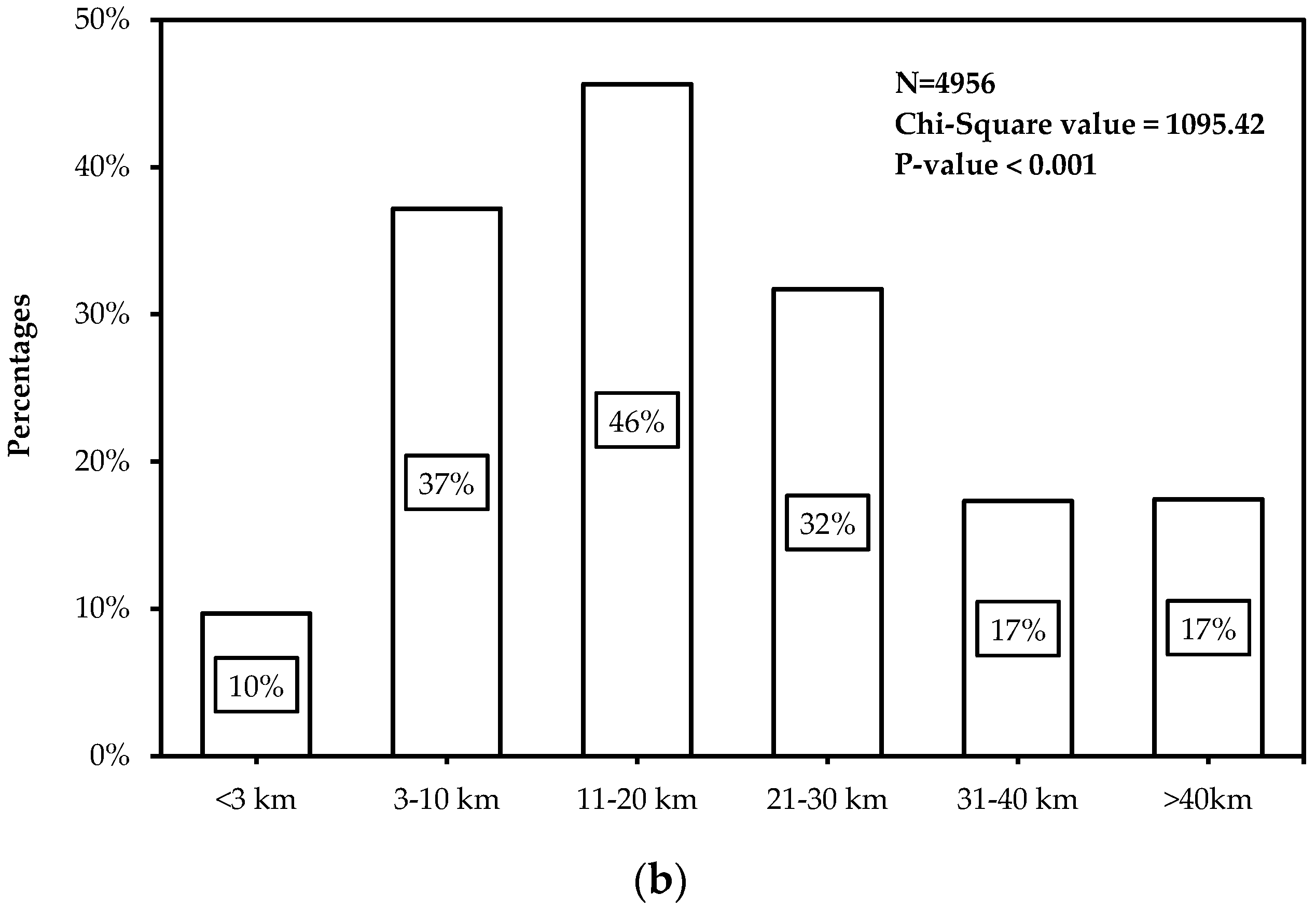
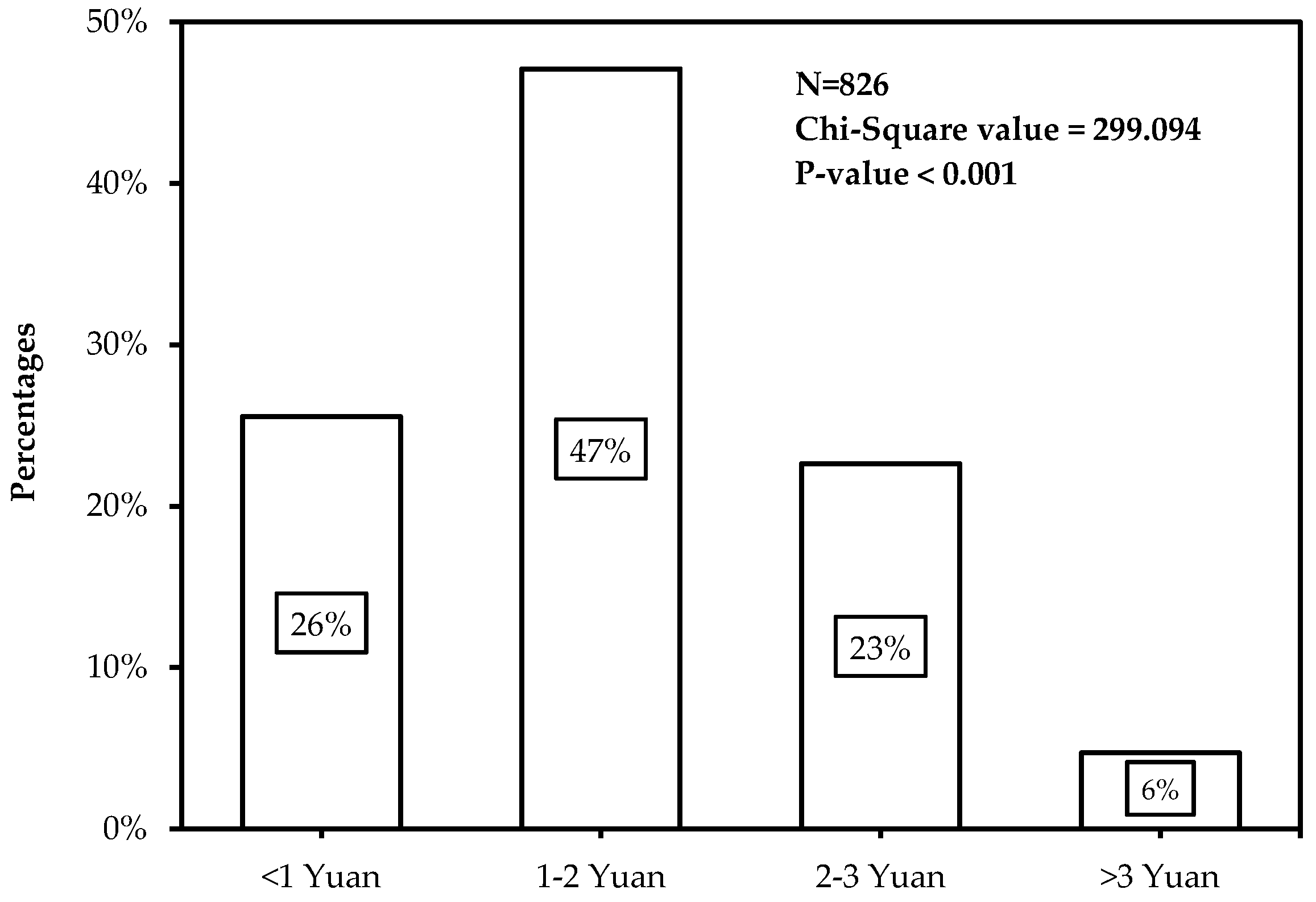
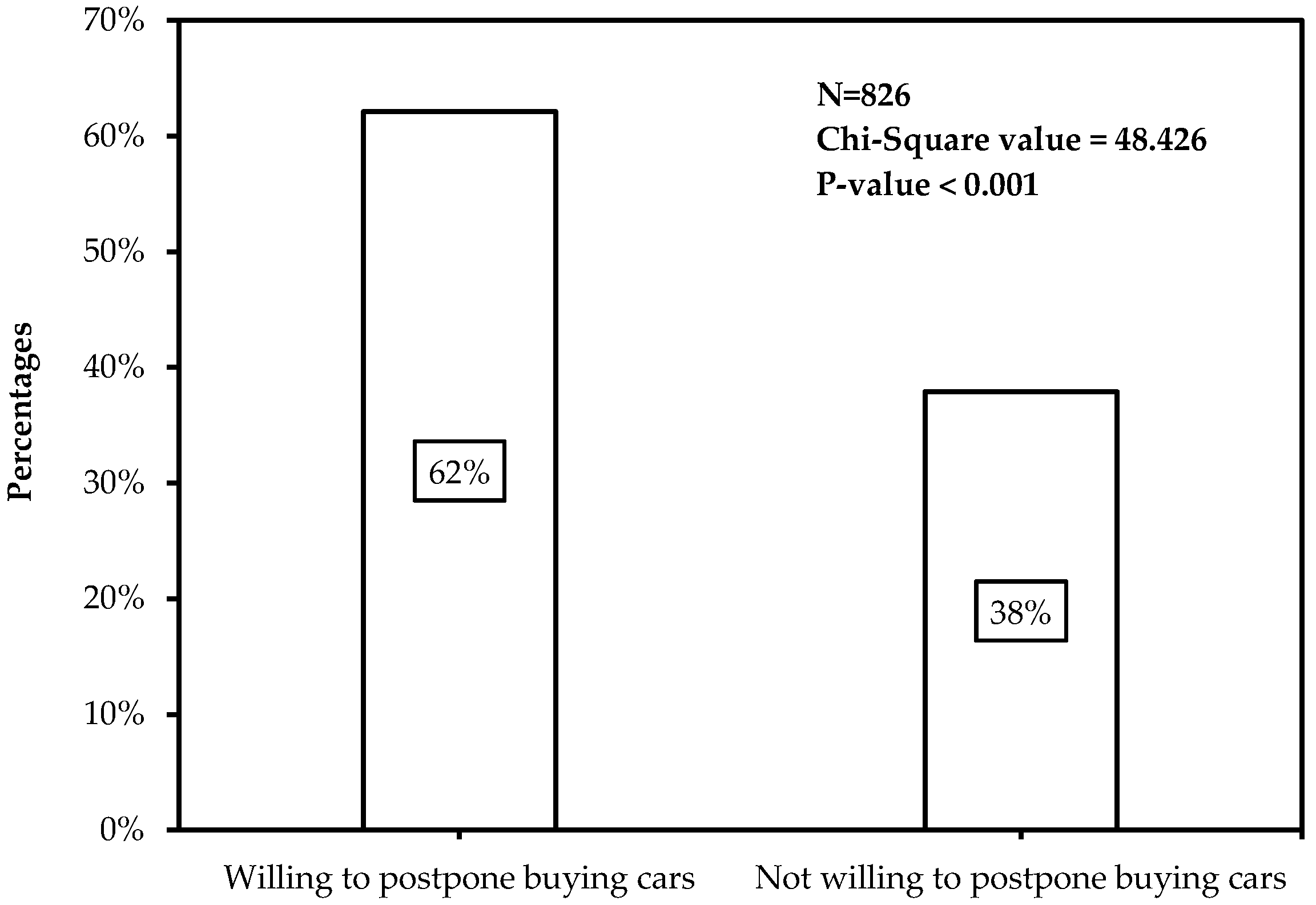
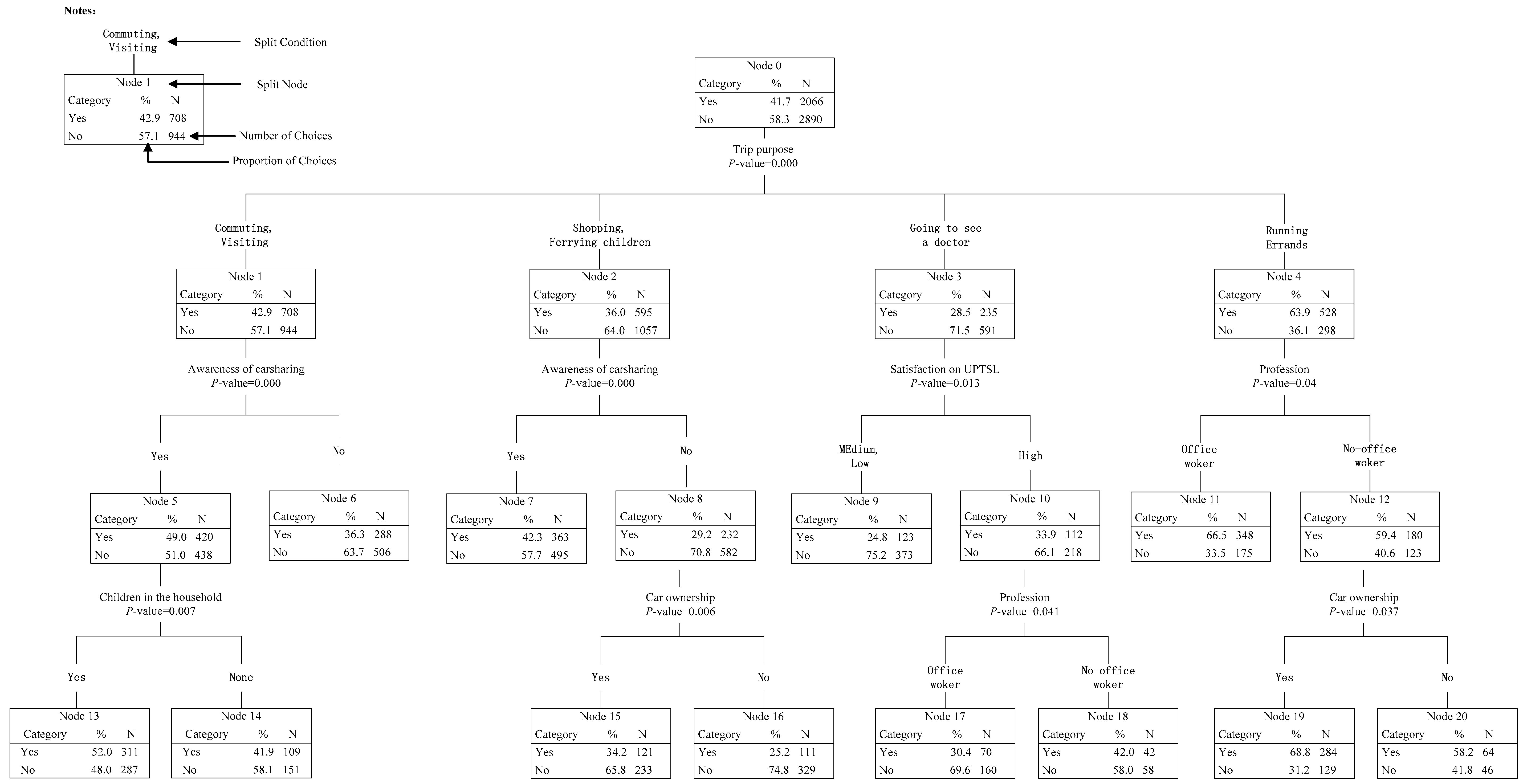
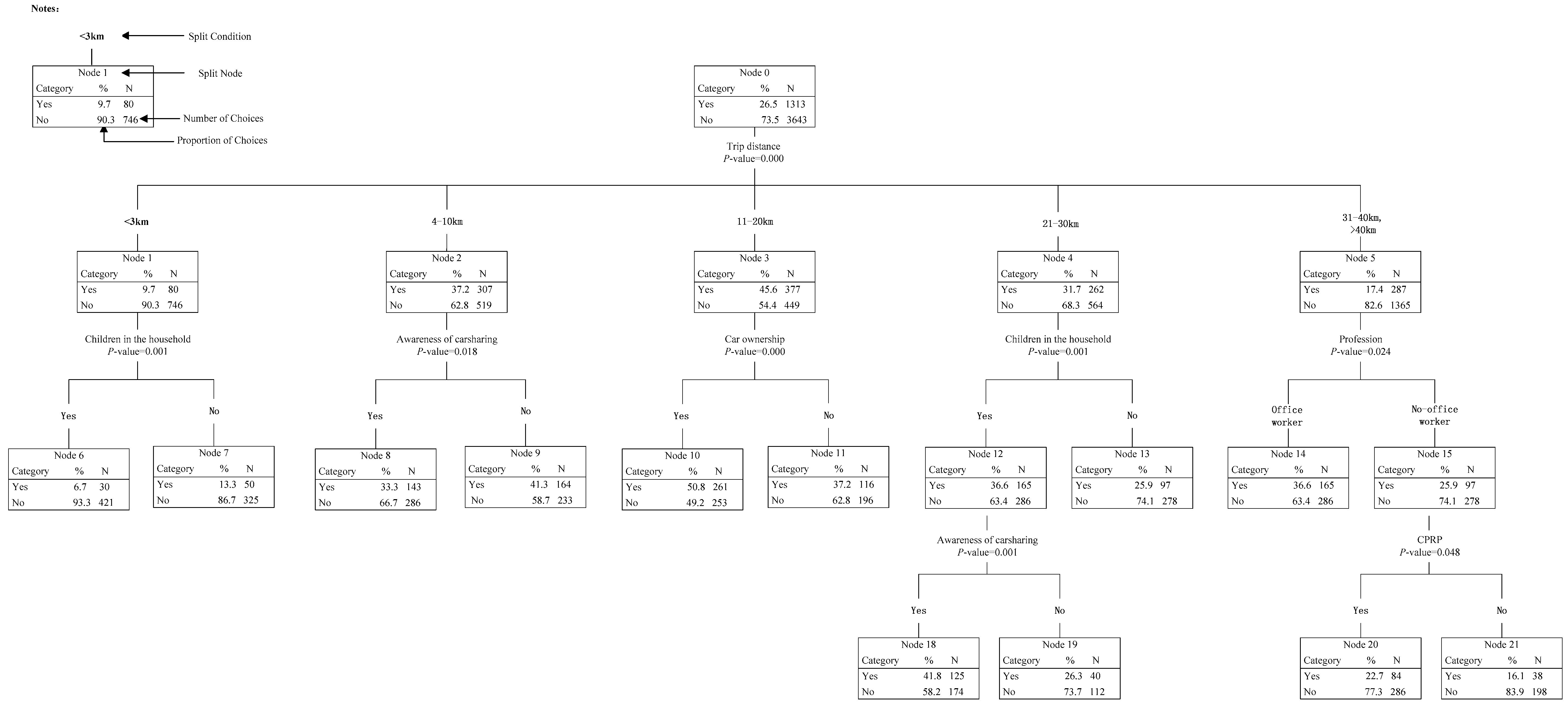

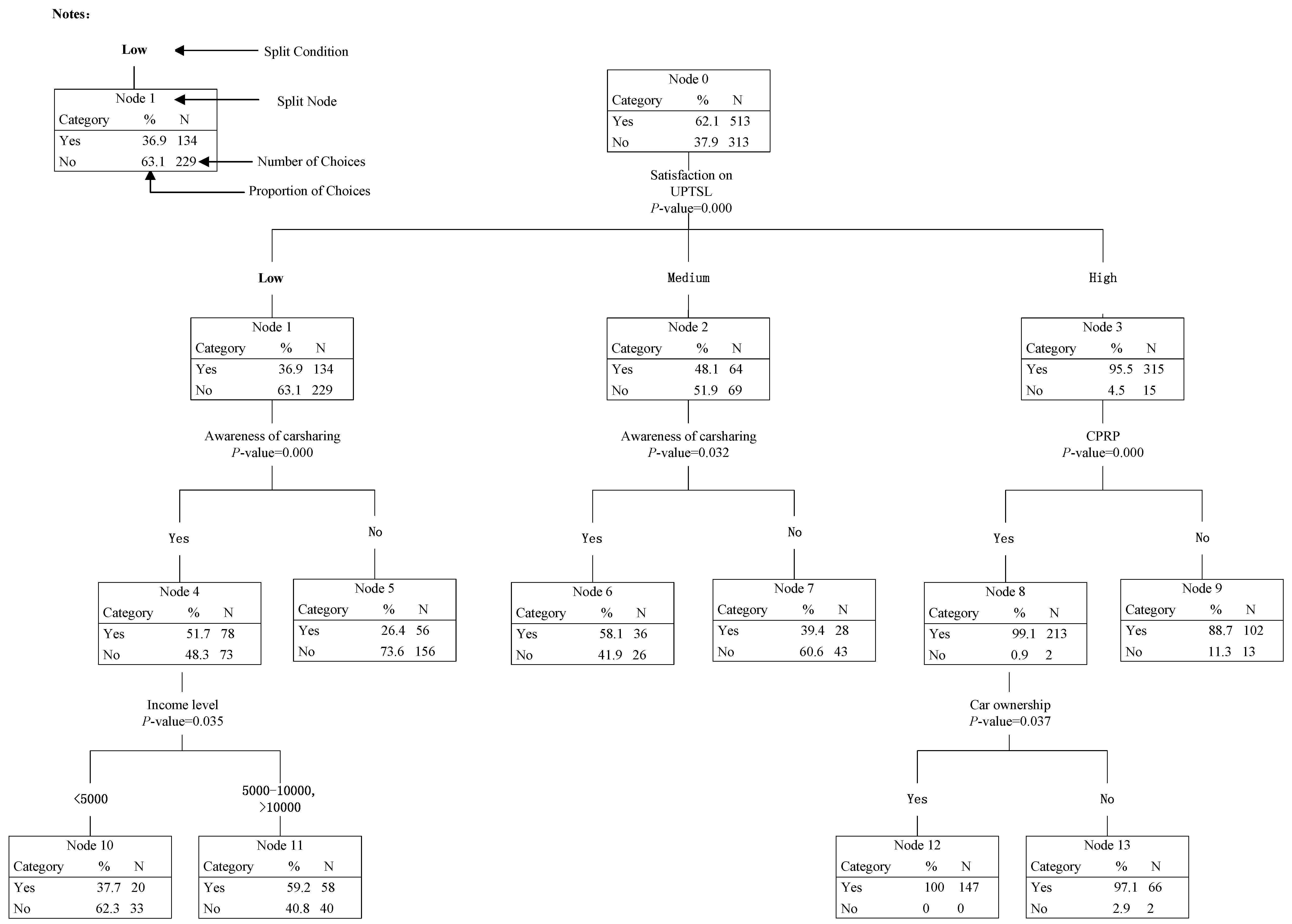
| Company | Operation Mode | Rental Time Unit | Battery Electric Vehicle (BEV) | Founded Time (Year) |
|---|---|---|---|---|
| eHi | One-way | Day | × | 2006 |
| Shenzhou | One-way | Day | × | 2007 |
| City Car Club | Round-trip | Day | × | 2010 |
| YiDuo | One-way | Day | × | 2010 |
| GreenGo | Round-trip | Minute | √ | 2014 |
| Car2go | Free-floating | Minute | × | 2015 |
| PanDa | One-way | Minute | √ | 2015 |
| Hertz | One-way | Day | × | 2015 |
| ZhiDou | Free-floating | Minute | √ | 2015 |
| EVCARD | One-way | Minute | √ | 2015 |
| TOGO | Free-floating | Minute | × | 2015 |
| YouChe | One-way | Minute | √ | 2015 |
| MoCar | Free-floating | Minute | × | 2016 |
| LeShare | One-way | Minute | √ | 2016 |
| JiaBei | One-way | Minute | √ | 2016 |
| DaDa | One-way | Minute | √ | 2016 |
| ShareGo | One-way | Minute | √ | 2016 |
| GoFun | One-way | Minute | √ | 2017 |
| eVpop | One-way | Minute | √ | 2017 |
| Independent Variables | Description/Levels | Summary Statistics | |
|---|---|---|---|
| N | % | ||
| Car purchase restriction policy (CPRP) | Have | 546 | 33.9 |
| Not have | 280 | 66.1 | |
| Urban public transport service level (UPTSL) | Low | 363 | 43.9 |
| Medium | 133 | 16.1 | |
| High | 330 | 40 | |
| Gender | Male | 420 | 50.8 |
| Female | 406 | 49.2 | |
| Age (year) | <20 | 52 | 6.3 |
| 21–30 | 472 | 57.1 | |
| 31–40 | 233 | 28.2 | |
| 41–50 | 53 | 6.4 | |
| Above 50 | 16 | 1.9 | |
| Profession | Office worker | 523 | 63.3 |
| Non-office worker | 303 | 36.7 | |
| Education level | Low-education | 110 | 13.3 |
| Middle-education | 612 | 74.1 | |
| High-education | 104 | 12.6 | |
| Personal income (¥) | Low-income | 405 | 49.0 |
| Middle-income | 296 | 34.8 | |
| High-income | 125 | 15.1 | |
| Children in the household | None | 375 | 45.4 |
| Yes | 451 | 54.6 | |
| Car ownership | Have a car | 514 | 62.2 |
| Do not have a car | 312 | 37.8 | |
| Awareness of carsharing | Know about carsharing | 429 | 51.9 |
| Do not know about carsharing | 397 | 48.1 | |
| Price of carsharing vehicles | Below 100,000 Yuan | 336 | 40.7 |
| 100 to 200,000 Yuan | 319 | 38.6 | |
| 200 to 300,000 Yuan | 138 | 16.7 | |
| Above 300,000 Yuan | 33 | 4.0 | |
| Trip purpose | Commute | 826 | 16.7 |
| Shopping | 826 | 16.7 | |
| Go to the doctor | 826 | 16.7 | |
| Visit relatives and friends | 826 | 16.7 | |
| Business activity | 826 | 16.7 | |
| Ferry children | 826 | 16.7 | |
| Trip distance | Trip distance less than 3 km | 826 | 16.7 |
| Trip distance between 3 and 10 km | 826 | 16.7 | |
| Trip distance between 10 and 20 km | 826 | 16.7 | |
| Trip distance between 20 and 30 km | 826 | 16.7 | |
| Trip distance between 30 and 40 km | 826 | 16.7 | |
| Trip distance more than 40 km | 826 | 16.7 | |
| Independent Variables | <1 Yuan | 1–2 Yuan | 2–3 Yuan | >3 Yuan | Total | |||||
|---|---|---|---|---|---|---|---|---|---|---|
| N | % | N | % | N | % | N | % | N | % | |
| By CPRP | ||||||||||
| Have | 126 | 23 | 264 | 48 | 133 | 25 | 23 | 4 | 546 | 100 |
| Not have | 85 | 30 | 125 | 45 | 54 | 19 | 16 | 6 | 280 | 100 |
| By UPTSL | ||||||||||
| Low | 102 | 28 | 165 | 46 | 79 | 22 | 17 | 5 | 363 | 100 |
| Medium | 38 | 29 | 59 | 44 | 28 | 21 | 8 | 6 | 133 | 100 |
| High | 71 | 22 | 165 | 50 | 80 | 24 | 14 | 4 | 330 | 100 |
| By gender | ||||||||||
| Male | 98 | 23 | 189 | 45 | 108 | 26 | 25 | 6 | 420 | 100 |
| Female | 113 | 28 | 200 | 50 | 79 | 20 | 14 | 3 | 406 | 100 |
| By age (year) | ||||||||||
| <20 | 15 | 29 | 22 | 42 | 11 | 21 | 4 | 8 | 52 | 100 |
| 21–30 | 121 | 26 | 233 | 49 | 99 | 21 | 19 | 4 | 472 | 100 |
| 31–40 | 51 | 23 | 106 | 48 | 64 | 29 | 12 | 5 | 233 | 100 |
| 41–50 | 16 | 30 | 23 | 43 | 12 | 23 | 2 | 4 | 53 | 100 |
| >50 | 8 | 50 | 5 | 31 | 1 | 6 | 2 | 13 | 16 | 100 |
| By profession | ||||||||||
| Non-office worker | 93 | 31 | 142 | 47 | 57 | 19 | 11 | 3 | 303 | 100 |
| Office worker | 118 | 23 | 247 | 47 | 130 | 25 | 28 | 5 | 523 | 100 |
| By monthly income | ||||||||||
| Low-income | 141 | 35 | 195 | 48 | 55 | 14 | 14 | 4 | 405 | 100 |
| Middle-income | 58 | 20 | 141 | 48 | 82 | 28 | 15 | 5 | 296 | 100 |
| High-income | 12 | 10 | 53 | 42 | 50 | 40 | 10 | 8 | 125 | 100 |
| By education level | ||||||||||
| Low-education | 35 | 32 | 53 | 48 | 15 | 14 | 7 | 6 | 110 | 100 |
| Middle-education | 152 | 25 | 283 | 46 | 149 | 24 | 28 | 5 | 612 | 100 |
| High-education | 24 | 23 | 53 | 51 | 23 | 22 | 4 | 4 | 104 | 100 |
| By child | ||||||||||
| No | 116 | 31 | 180 | 48 | 63 | 17 | 16 | 4 | 375 | 100 |
| Yes | 95 | 21 | 209 | 46 | 124 | 27 | 23 | 5 | 451 | 100 |
| By car ownership | ||||||||||
| Have a car | 101 | 20 | 245 | 48 | 141 | 27 | 27 | 5 | 514 | 100 |
| Do not have a car | 110 | 35 | 144 | 46 | 46 | 15 | 12 | 4 | 312 | 100 |
| By awareness of carsharing | ||||||||||
| Know about carsharing | 67 | 16 | 211 | 49 | 130 | 30 | 21 | 5 | 429 | 100 |
| Do not know about carsharing | 144 | 36 | 178 | 45 | 57 | 14 | 18 | 5 | 397 | 100 |
| By price of carsharing vehicle | ||||||||||
| Below 100,000 Yuan | 135 | 40 | 154 | 46 | 35 | 10 | 12 | 4 | 336 | 100 |
| 100 to 200,000 Yuan | 66 | 21 | 166 | 52 | 73 | 23 | 14 | 4 | 319 | 100 |
| 200 to 300,000 Yuan | 8 | 6 | 57 | 41 | 63 | 46 | 10 | 7 | 138 | 100 |
| Above 300,000 Yuan | 2 | 6 | 12 | 36 | 16 | 49 | 3 | 9 | 33 | 100 |
| Independent Variables | Willing to Forgo Car Purchases | Not Willing to Forgo Car Purchases | ||
|---|---|---|---|---|
| N | % | N | % | |
| By CPRP | ||||
| Have | 359 | 66 | 187 | 34 |
| Not have | 154 | 55 | 126 | 45 |
| By UPTSL | ||||
| Low | 134 | 37 | 229 | 63 |
| Medium | 64 | 48 | 69 | 52 |
| High | 315 | 95 | 15 | 5 |
| By gender | ||||
| Male | 256 | 61 | 164 | 39 |
| Female | 257 | 63 | 149 | 37 |
| By age (year) | ||||
| <20 | 21 | 40 | 31 | 60 |
| 21–30 | 280 | 59 | 192 | 41 |
| 31–40 | 163 | 70 | 70 | 30 |
| 41–50 | 38 | 72 | 15 | 28 |
| >50 | 11 | 69 | 5 | 31 |
| By profession | ||||
| Non-office worker | 167 | 55 | 136 | 45 |
| Office worker | 346 | 66 | 177 | 34 |
| By monthly income | ||||
| Low-income | 234 | 58 | 171 | 42 |
| Middle-income | 194 | 66 | 102 | 34 |
| High-income | 85 | 68 | 40 | 32 |
| By education level | ||||
| Low-education | 66 | 60 | 44 | 40 |
| Middle-education | 390 | 64 | 222 | 36 |
| High-education | 57 | 55 | 47 | 45 |
| By child | ||||
| No | 194 | 52 | 181 | 48 |
| Yes | 319 | 71 | 132 | 29 |
| By car ownership | ||||
| Have a car | 340 | 66 | 174 | 34 |
| Do not have a car | 173 | 55 | 139 | 45 |
| By awareness of carsharing | ||||
| Know about carsharing | 324 | 76 | 105 | 24 |
| Do not know about carsharing | 189 | 47 | 208 | 53 |
| By price of carsharing vehicle | ||||
| Below 100,000 Yuan | 190 | 56 | 146 | 44 |
| 100 to 200,000 Yuan | 207 | 65 | 112 | 35 |
| 200 to 300,000 Yuan | 95 | 69 | 43 | 31 |
| Above 300,000 Yuan | 21 | 64 | 12 | 36 |
© 2017 by the authors. Licensee MDPI, Basel, Switzerland. This article is an open access article distributed under the terms and conditions of the Creative Commons Attribution (CC BY) license (http://creativecommons.org/licenses/by/4.0/).
Share and Cite
Wang, Y.; Yan, X.; Zhou, Y.; Xue, Q.; Sun, L. Individuals’ Acceptance to Free-Floating Electric Carsharing Mode: A Web-Based Survey in China. Int. J. Environ. Res. Public Health 2017, 14, 476. https://doi.org/10.3390/ijerph14050476
Wang Y, Yan X, Zhou Y, Xue Q, Sun L. Individuals’ Acceptance to Free-Floating Electric Carsharing Mode: A Web-Based Survey in China. International Journal of Environmental Research and Public Health. 2017; 14(5):476. https://doi.org/10.3390/ijerph14050476
Chicago/Turabian StyleWang, Yun, Xuedong Yan, Yu Zhou, Qingwan Xue, and Li Sun. 2017. "Individuals’ Acceptance to Free-Floating Electric Carsharing Mode: A Web-Based Survey in China" International Journal of Environmental Research and Public Health 14, no. 5: 476. https://doi.org/10.3390/ijerph14050476






